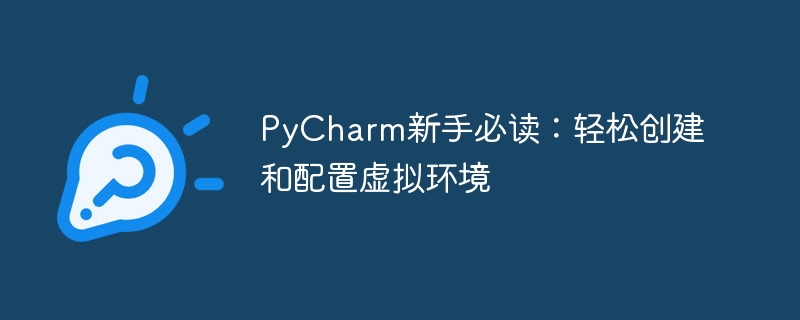

PyCharm, as a powerful Python integrated development environment (IDE), has extremely high visibility and usage in the field of Python development. For novices, mastering the use of PyCharm is crucial to improving development efficiency and optimizing the development experience. Among them, creating and configuring a virtual environment is a very basic but very important skill, which plays an important role in project isolation and dependency management. This article will introduce how to easily create and configure a virtual environment in PyCharm, and attach specific code examples to help novices master this skill as soon as possible.
In Python development, the virtual environment is an independent Python running environment independent of the system Python environment. It can create a clean development environment to avoid dependency conflicts between different projects. Through a virtual environment, we can run different versions of Python, install different packages, and other operations on the same machine, making development work more flexible.
In PyCharm, creating a virtual environment is very simple. We can complete it by following the following steps:
After creating the virtual environment, we need to configure it as the default Python interpreter in PyCharm to ensure that the virtual environment is used in the project. The following are the specific configuration steps:
The following is a simple sample code that demonstrates how to use the created virtual environment in PyCharm:
# 创建虚拟环境成功后,在PyCharm中编写代码如下:
# 导入所需包
import pandas as pd
# 创建一个DataFrame
data = {'Name': ['Alice', 'Bob', 'Charlie'],
'Age': [25, 30, 35]}
df = pd.DataFrame(data)
# 打印DataFrame
print(df)Through the introduction of this article, I believe that readers have mastered the method of creating and configuring a virtual environment in PyCharm, and learned how to use a virtual environment in a project for Python development through sample code. Mastering the creation and configuration of virtual environments is of great significance to improving the development efficiency and maintainability of Python projects. Novice developers should keep this skill in mind and continue to practice and improve it. I hope this article will be helpful to PyCharm newbies, allowing them to adapt to and master Python development faster.
The above is the detailed content of A must-read for new PyCharm users: Easily create and configure virtual environments. For more information, please follow other related articles on the PHP Chinese website!
 How to change pycharm to Chinese
How to change pycharm to Chinese
 pycharm installation tutorial
pycharm installation tutorial
 How to solve the problem that pycharm cannot find the module
How to solve the problem that pycharm cannot find the module
 How to install pycharm
How to install pycharm
 The difference between python and pycharm
The difference between python and pycharm
 How to configure the pycharm environment
How to configure the pycharm environment
 How to install the pycharm interpreter
How to install the pycharm interpreter
 What does pycharm mean when running in parallel?
What does pycharm mean when running in parallel?




